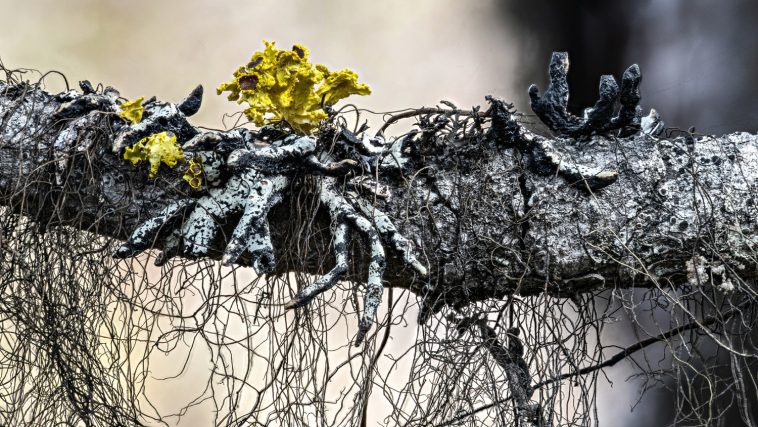[Originally published in 2017 as Lichen Kept This Secret from Scientists for Almost 150 Years!]
If you have been reading this blog for a while, you know that I am fascinated by mutualism – the phenomenon where two organisms of different species work together to benefit one another (see here, here, here, here, and here, for example). Creationists expect such relationships to be common throughout nature, and at least one line of research seems to indicate that some organisms are designed to produce them.
I suspect that we understand very little about this amazing process, and it is probably more common than most scientists think.
Consider, for example, the longest-studied mutualistic relationship.
Way back in 1867, Swiss botanist Dr. Simon Schwendener proposed that a lichen (like the one pictured to the left) is not a single organism. Instead, it is composed of two different organisms, a fungus and an alga (the singular form of algae), that work together so that each benefits. His hypothesis was rejected by the scientific consensus, but as has been the case throughout the history of science, the consensus was demonstrated to be wrong, and Dr. Schwendener was vindicated.
Nowadays, the lichen is one of the most common examples given to explain the concept of mutualism. The alga does photosynthesis and shares its food and oxygen with the fungus, while the fungus supports the alga and supplies it with water and salts.
You would think that since Dr. Schwendener proposed this mutualistic relationship nearly 150 years ago, scientists would know pretty much everything there is to know about lichen.
However, there was one major mystery that hadn’t been solved over that entire timespan:
how can genetically similar lichen be so wildly different?
The picture above, for example, is of a specific lichen, Bryoria fremontii. Another lichen from the same genus, Bryoria tortuosa, is composed of the same species of fungus and the same species of alga. From a genetic standpoint, the fungus and alga in both lichens are virtually identical. Nevertheless, one lichen is brown while the other is yellow. In addition, one produces a chemical known as vulpinic acid, while the other does not.
How can two lichen composed of genetically-identical partners look and behave so differently? We may now know the answer, which has been hiding in plain sight for almost 150 years!
According to research published in 2016, these lichen are actually composed of three distinct organisms! The third organism, a yeast, is found in the cortex of the fungus. Variations in this yeast account for the variations seen among lichen that were once thought to be composed of genetically-identical partners. In the case of the two lichens discussed above, for example, the production of acid is the result of the yeast in the fungus.
The researchers who produced this remarkable study found evidence for yeast in 52 genera of lichen from six different continents. As a result, they suggest that most lichens are composed of three different organisms in a mutualistic relationship (a fungus, an alga, and a yeast)*. I have written about the phenomenon of three-way mutualism before (see here, here, and here). This one is particularly striking, however, because the third partner in the relationship has been overlooked for almost 150 years. Why was it overlooked? In their paper, the authors of this study have a suggestion:
The assumption that stratified lichens are constructed by a single fungus with differentiated cell types is so central to the definition of the lichen symbiosis that it has been codified into lichen nomenclature. This definition has brought order to the field but may also have constrained it by forcing untested assumptions about the true nature of the symbiosis.
[Note: Symbiosis is a more general term that includes mutualism.]
In other words, the assumption that there were only two organisms involved had been ingrained into the very study of lichens. As a result, whenever anyone saw any evidence of a third partner in the relationship, it was dismissed. After all, the scientific consensus was that lichens are composed of two organisms. Of course, had other scientists who were studying lichens in the past remembered that the scientific consensus is often wrong, they might have been the ones to make this paradigm-changing discovery.
Let that be a lesson to all scientists (present and future). The scientific consensus is often wrong. It is better to follow the data than to follow the consensus!
H/T Dr. Todd Wood: I somehow missed this study when it came out, but it was in Dr. Wood’s “Top 12 Science & Creation Stories”.
NOTE: A yeast is also a fungus. However, it is in a different phylum (Basidiomycota) from the fungus that was already known (which is in Ascomycota).
Return to Text







